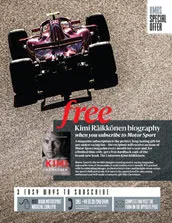

The best, simply
In 1981 a young Brazilian arrived in the UK, straight out of karting. He spoke barely any English and carried little money. Who would have thought that boy formerly known…

For the first time in its illustrious history the Victoria & Albert will be putting on an exhibition about cars. It seems extraordinary that the museum – which has had its finger on the pulse of fashion since 1852 and has had exhibits on everything from ceramic tiles to kitchen gadgets, ocean liners to the history of plywood, could have overlooked automotive design classics such as the Mercedes 90, the Plymouth Barracuda, E-type – and Nissan Cube. But there you go.
In any case the new exhibition, which is due to open in November but had its launch event at the end of April, is set to right old oversights with a delicious sounding show, covering the evolution of the car and its impact on the world. It will include, among its 250 objects, an autonomous flying car, a converted low-rider, and a 1950s concept car as well as the first production car manufactured, the 1887 Benz Patent Motorwagen, although it is unclear whether this is the actual original car, or one of the replicas that Mercedes lends out for exhibitions.
Over bacon-and-egg sandwiches at the wonderfully decorated Michelin House in Chelsea, with its murals of pioneering motor racing, the curator of the show Brendan Cormier told us: “The V&A’s mission is to champion the power of design to change the world, and no other design object has impacted the world more than the automobile. This exhibition is about the power of design to effect change, and the unintended consequences that have contributed to our current environmental situation.”
There is an irony in the fact that the V&A, known for its focus on fashion, will be celebrating cars at a time when they have never been more unfashionable. Certainly the team behind the exhibit will be breathing a sigh of relief that the show isn’t opening this month, when members of the so called Extinction Rebellion staged a “lie-in” under the blue whale skeleton of its neighbour the Natural History Museum. And as Tristram Hunt, the director of the V&A admitted, it hadn’t been an easy decision to give the go-ahead to the exhibition. Still, credit where it is due: perhaps cars are finally being accepted into polite society.
For readers of Motor Sport the best part of Cars: Accelerating the Modern World is set to be the section dedicated to racing. According to Cormier, this area will examine how – almost as soon as the car itself had been created – so too was the spark of competition. The two things happened almost in unison: no matter how fast your horseless carriage could go, someone somewhere else reckoned they could go faster. The same is clearly still true today.
The element of competition also fuelled innovation which, according to Cormier, who has spent a year and a half researching and curating the exhibition, found its apotheosis in the slippery shape of the streamliners of the pre-war years, such as the rear-engined Tatra T77, and rapidly filtered down into every area of life from fashion to household appliances.
Competition, of course, still fuels innovation: witness not only the drive towards electric power we are seeing across all forms of motor sport and the development of ingenious hybrid powertrains, but also tyre technology, carbon fibre, digital engineering and car connectivity. Perhaps the next car-themed exhibit to grace the V&A will come sooner than 2186.
Our features editor Simon Arron raised an interesting question about Formula 1’s commercial rights-holder Liberty Media branding the recent Chinese Grand Prix as F1’s 1000th race. It was certainly the 1000th event to count towards the world championship for drivers since its inception in 1950 but, he argued, only 974 of those were for F1 cars. Of the others, 11 were Indianapolis 500s while the remaining 15 were qualifying grands prix that ran to F2 regulations in 1952-53.
Of course, such figures take no heed of the many non-championship Formula 1 races (many of them titled ‘grand prix’ solely on the grounds of involving F1 cars) that took place between 1946 and 1983, when Brands Hatch’s final Race of Champions (won by Williams driver Keke Rosberg) marked the end of such practice – something still missed by many racing enthusiasts.
In 1962, there were 22 F1 races that did not count towards the world championship to complement the nine that did. In fact, the calendar was so congested that on June 11 there were clashing F1 fixtures in the UK. John Surtees (Lola Mk4) won the 2000 Guineas at Mallory Park while Innes Ireland (Lotus 24) swept to victory in the Crystal Palace Trophy, 125 miles away.
Different times.

Joe Dunn, editor
Follow Joe on Twitter @joedunn90